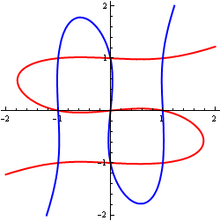Cramer's paradox (Q3363319)
Jump to navigation
Jump to search
the statement that the number of points of intersection of two planar higher-order curves can be greater than the number of arbitrary points usually needed to define one such curve
| Language | Label | Description | Also known as |
|---|---|---|---|
| English | Cramer's paradox |
the statement that the number of points of intersection of two planar higher-order curves can be greater than the number of arbitrary points usually needed to define one such curve |
Statements
Two cubic curves.png
250 × 251; 8 KB
250 × 251; 8 KB
example Cramer’s paradox: two cubic curves intersect in 9 points, even though 9 points in general position uniquely determine a cubic curve (English)
0 references
Identifiers
Sitelinks
Wikipedia(7 entries)
- elwiki Παράδοξο του Κράμερ
- enwiki Cramer's paradox
- frwiki Paradoxe de Cramer
- jawiki クラメールのパラドックス
- mkwiki Крамеров парадокс
- rowiki Paradoxul lui Cramer
- ruwiki Парадокс Крамера
